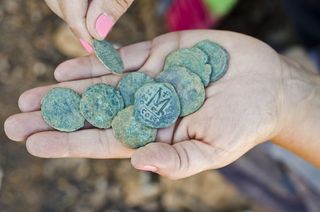Bronze Coins Engraved with Byzantine Emperors Found in Israel

About 1,400 years ago in Israel, a bag holding nine bronze coins was carefully hidden inside a niche in a building's wall. Untouched since then, the coin cache recently emerged during excavations for a highway expansion near Ein Hemed, a national park located about 4 miles (7 kilometers) west of Jerusalem.
The rare coins date to the Byzantine period, approximately the seventh century. Archaeologists discovered them inside a two-story building, near large stones that had collapsed.
The structure where the coins were found is part of a larger site that encompasses land on both sides of the highway. It likely represents property that was abandoned by the owners during a time of danger, possibly the Persian invasion in A.D. 614, which brought an end to Byzantine rule in the area, Israeli Antiquities Authority (IAA) representatives said in a statement describing the new discoveries. [Image Gallery: Ancient Treasure Trove Revealed]
"It seems that during a time of danger, the owner of the hoard placed the coins in a cloth purse that he concealed inside a hidden niche in the wall," Annette Landes-Nagar, the IAA director of the excavation, said in the statement.
"He probably hoped to go back and collect it, but today we know that he was unable to do so," Landes-Nagar said.

The coins are printed with the images of three Byzantine emperors: Justinian (A.D. 483 to 565), Maurice (A.D. 539 to 602) and Phocas (A.D. 547 to 610). The imperial figures are dressed for battle and carrying crosses, and the coins' denominations are printed on the reverse sides, along with the letter "M," according to IAA representatives.
About a year ago, excavations across the highway revealed the remains of a Byzantine church. Experts suspected that it was once a historic settlement called Einbikumakube, a word that echoes in the present name of a nearby Arab village, called Beit Naquba.
Sign up for the Live Science daily newsletter now
Get the world’s most fascinating discoveries delivered straight to your inbox.
The IAA and Netivei Israel, the national company responsible for developing transportation infrastructure, will collaborate to conserve the site and protect it as a landmark, Amit Shadman, the district archaeologist for Judah, said in the statement.
Original article on Live Science.

Mindy Weisberger is an editor at Scholastic and a former Live Science channel editor and senior writer. She has reported on general science, covering climate change, paleontology, biology, and space. Mindy studied film at Columbia University; prior to Live Science she produced, wrote and directed media for the American Museum of Natural History in New York City. Her videos about dinosaurs, astrophysics, biodiversity and evolution appear in museums and science centers worldwide, earning awards such as the CINE Golden Eagle and the Communicator Award of Excellence. Her writing has also appeared in Scientific American, The Washington Post and How It Works Magazine.

